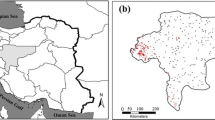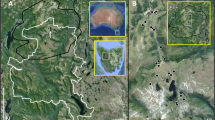Abstract
Vegetation response to wildfire has been studied extensively in upland ecosystems, but fire effects on temperate wetlands are less understood. We evaluated vegetation response to extensive wildfire in wetlands of Okefenokee National Wildlife Refuge (ONWR), USA, with a spatially explicit Bayesian belief network model informed with data recorded during 1990–2012. We assessed model accuracy and effects of fire frequency on vegetation composition with predictive scenarios of fire absence or a fire return interval (FRI) every 5 or 10 years during 2012–2032. In fire absence, shrubs increased 100%, primarily in the northern half of the Refuge, while the herbaceous class that was widespread in 2012 was eliminated. Areas dominated by forest during the past ~65 years were maintained with the 5- and 10-year FRI. Herbaceous-dominated areas maintained with the 5-year FRI decreased (90%) with the 10-year FRI. Shrub coverage increased with fire (17%, 5-year FRI; 20%, 10-year FRI), while scrub/shrub decreased (12%; 5-year FRI) or increased (6%; 10-year FRI). A 5-year FRI during conditions promoting severe fire may maintain the distribution of herbaceous and forested areas that followed an extensive drought and fires in 2011, and may limit scrub/shrub expansion that previously occurred with longer FRIs in the ONWR.








Similar content being viewed by others
References
Beckage B, Platt WJ, Slocum MG, Panko B (2003) Influence of the El Niño southern oscillation on fire regimes in the Florida Everglades. Ecology 84:3124–3130
Beckage B, Platt WJ (2003) Predicting severe wildfire years in the Florida Everglades. Frontiers in Ecology and the Environment 1:235–239
Beckage B, Platt WJ, Panko B (2005) A climate-based approach to the restoration of fire dependent ecosystems. Restoration Ecology 13:429–431
Beyer HL (2012). Geospatial modelling environment (version 0.7.2.0). URL: http://www.spatialecology.com/gme
Bond WJ, van Wilgen BW (1996) Fire and plants. Chapman and hall. England, London
Cansler CA, McKenzie D (2012) How robust are burn severity indices when applied in a new region? Evaluation of alternative field-based and remote-sensing methods. Remote Sensing 4:456–483
Cansler CA, McKenzie D (2014) Climate, fire size, and biophysical setting control fire severity and spatial pattern in the northern Cascade range, USA. Ecological Applications 24:1037–1056
Chapin III FS, McGuire AD, Randerson J, Pielke R Sr., Baldocchi D, Hobbie SE, Roulet N, Eugster W, Kasischke E, Rastetter EB, Zimov SA, and Running SW (2000) Arctic and boreal ecosystems of western North America as components of the climate system. Global Change Biol 6 (Suppl. 1):211-223
Cohen AD (1973) Possible influences of subpeat topography and sediment type upon the development of the Okefenokee swamp-marsh complex of Georgia. Southeastern Geology 15:141–151
Cohen AD, Andrejko MJ, Spackman W, Corvinus D (1984) Peat deposits in the Okefenokee swamp. In: Cohen AJ, Casagrande DJ, Andrejko MJ, Best GR (eds) The Okefenokee swamp: its natural history, geology, and geochemistry. Wetlands Surveys, Los Alamos, New Mexico, pp 493–553
Cypert E (1961) The effects of fires in the Okefenokee swamp in 1954 and 1955. The American Midland Naturalist 66:483–503
Cypert E (1973) Plant succession on burned areas in Okefenokee swamp followingthe fires of 1954 and 1955. In: Pages 199–217 in proceedings of the 12th annual tall timbers fire ecology conference. Tall Timbers Research Station, Tallahassee Florida
Duever MJ (1982) Hydrology-plant community relationships in the Okefenokee swamp. Florida. Scientist 45:171–176
Duever MJ, Riopelle LA (1983) Successional sequences and rates on tree islands in the Okefenokee swamp. The American Midland Naturalist 110:186–193
Duever MJ, Riopelle LA (1984a) Successional patterns and rates on Okefenokee swamp tree islands. In: Cohen AJ, Casagrande DJ, Andrejko MJ, Best GR (eds) The Okefenokee swamp: its natural history, geology, and geochemistry. Wetlands Surveys, Los Alamos, New Mexico, pp 112–131
Duever MJ, Riopelle LA (1984b) Tree-ring analysis in the Okefenokee swamp. In: Cohen AJ, Casagrande DJ, Andrejko MJ, Best GR (eds) The Okefenokee swamp: its natural history, geology, and geochemistry. Wetlands Surveys, Los Alamos, New Mexico, pp 180–188
Dlamini WM (2010) A Bayesian belief network analysis of factors influencing wildfire occurrence in Swaziland. Environmental Modelling and Software 25:199–208
ESRI (2010) ArcGIS desktop: release 10. Environmental Systems Research Institute, Redlands, CA
Falk DA, Miller C, McKenzie D, Black AE (2007) Cross-scale analysis of fire regimes. Ecosystems 10:809–823
Flannigan MD, Stocks BJ, Wooton BM (2000) Climate change and forest fires. Science Total Environment 262:221–229
Galan CO, Matias JM, Rivas T, Bastante FG (2009) Reforestation planning using Bayesian networks. Environmental Modelling and Software 24:1285–1292
Gerritsen J, Greening HS (1989) March seed banks of the Okefenokee swamp: effects of hydrologic regime and nutrients. Ecology 70:750–763
Hamilton DB (1982) Plant succession and the influence of disturbance in the Okefenokee swamp. Dissertation, University of Georgia, Athens, Georgia, Georgia. Ph.D 254 pp
Hamilton DB (1984) Succession and the influence of disturbance in Okefenokee swamp. In: Cohen AJ, Casagrande DJ, Andrejko MJ, Best GR (eds) The Okefenokee swamp: its natural history, geology, and geochemistry. Wetlands Surveys, Los Alamos, New Mexico, pp 86–111
Harden JW, Trumbore SE, Stocks BJ, Hirsch A, Gower ST, O'Neill KP, and Kasischke ES (2000) The role of fire in the boreal carbon budget. Global Change Biol 6 (suppl. 1):174–184
Heilman WE, Potter BE, Zerbe JI (1998) Regional climate change in the southern United States: the implications for wildfire occurrence. In: Mickler RA, Fox S (eds) The Productivity & Sustainability of southern Forest ecosystems in a changing environment. Springer-Verlag. New York, New York, pp 683–699
Karl TR, Melillo JM, Peterson TC (eds) (2009) Global climate change impacts in the United States. Cambridge University Press, Cambridge, England
Loftin, C.S. (1998) Accessing patterns and processes of landscape change in Okefenokee swamp, Georgia. Ph.D. dissertation, Department of Wildlife Ecology and Conservation, University of Florida, Gainesville, Florida
Loftin CS, Kitchens WM, Ansay N (2001) Development and application of a spatial hydrology model of Okefenokee swamp, Georgia. Journal of the American Water Resources Association 37:935–956
Madoui A, Leduc A, Gauthier S, Bergeron Y (2010) Spatial pattern analyses of post-fire residual stands in the black spruce boreal forest of western Quebec. International Journal of Wildland Fire 19:1110–1126
Marcot BG, Steventon JD, Sutherland GD, McCann RK (2006) Guidelines for developing and updating Bayesian belief networks applied to ecological modeling and conservation. Canadian Journal of Forest Research 36:3063–3074
McCaffrey CA, Hamilton DB (1984) Vegetation mapping of the Okefenokee swamp ecosystem. In: Cohen AJ, Casagrande DJ, Andrejko MJ, Best GR (eds) The Okefenokee swamp: its natural history, geology, and geochemistry. Wetlands Surveys, Los Alamos, New Mexico, pp 201–211
McCloskey JT (2006) Evaluating effects of fire management policy on vegetation communities in the Okefenokee swamp. Dissertation, The University of Maine, Orono, Maine, Georgia. Ph.D
McGarigal K, Cushman SA, Ene E (2012) FRAGSTATS v4: spatial pattern analysis program for categorical and continuous maps. Computer software program produced by the authors at the university of Massachusetts. Amherst, URL http://www.umass.edu/landeco/research/fragstats/fragstats.html
McKenzie D, Miller C, Falk DA (2011) Toward a theory of landscape fire. In: McKenzie D, Miller C, Falk DA (eds) The landscape ecology of fire. Springer Science+Business Media, New York, pp 3–25
McKenzie D, Kennedy MC (2012) Power laws reveal phase transitions in landscape controls of fire regimes. Nature Communications 3:726. https://doi.org/10.1038/ncomms1731.www.nature.com/naturecommunications.
Meyn A, White PS, Buhk C, Jentsch A (2007) Environmental drivers of large, infrequent wildfires: the emerging conceptual model. Progress in Physical Geography 31:287–312
Mitsch WJ, Day JW Jr (2004) Thinking big with whole-ecosystem studies and ecosystem restoration—a legacy of H.T. Odum. Ecological Modelling 178:133–155
Morgan P, Hardy CC, Swetman TW, Rollins MG, Long DG (2001) Mapping fire regimes across time and space: understanding coarse and fine-scale fire patterns. International Journal of Wildland Fire 10:329–342
Moritz MA, Morais ME, Summerell LA, Carlson JM, Doyle J (2005) Wildfires, complexity, and highly optimized tolerance. Proceedings of the National Academy of Sciences 102:17912–17917
Moritz MA, Hessburg PF, Povak NA (2011) Native fire regimes and landscape resilience. In: McKenzie D, Miller C, Falk DA (eds) The landscape ecology of fire. Springer Science+Business Media, New York, pp 51–86
Murray JV, Stokes KE, van Klinken RD (2012) Predicting the potential distribution of a riparian invasive plant: the effects of changing climate, flood regimes and land-use patterns. Global Change Biology 18:1738–1753
Norsys Software Corporation (2012) Netica® version 5. Vancouver, Canada, p 09
Parks SA, Dillon GK, Miller C (2014) A new metric for quantifying burn severity: the relativized burn ratio. Remote Sensing 6:1827–1844
Penman TD, Price O, Bradstock RA (2011) Bayes nets as a method for analysing the influence of management actions in fire planning. International Journal of Wildland Fire 20:909–920
Peters DPC, Pielke RA Sr, Bestelmeyer BT, Allen CD, Munson-McGee S, Havstad KM (2004) Cross-scale interactions, nonlinearities, and forecasting catastrophic events. Proceedings of the National Academy of Sciences 101:15130–15135
Peterson G, Allen CR, Holling CS (1998) Ecological resilience, biodiversity, and scale. Ecosystems 1:6–18
R Core Team (2012) R: a language and environment for statistical computing. In: R Foundation for Statistical Computing, Vienna, Austria. ISBN 3–900051–07-0 URL http://www.R-project.org/
Romme WH, Turner MG (2004) Ten years after the 1988 Yellowstone fires: is restoration needed? In: Wallace LL (ed) After the fires: the ecology of change in Yellowstone National Park. Yale University Press, New Haven, Connecticut, pp 318–361
Schoennagel T, Smithwick EAH, Turner MG (2008) Landscape heterogeneity following large fires: insights from Yellowstone National Park, USA. International Journal of Wildland Fire 17:742–753
Stassopoulou A, Petrou M, Kittler J (1998) Application of a Bayesian network in a GIS based decision making system. International Journal of Geographical Information Science 12:23–45
Stelzenmüller V, Lee J, Garnacho E, Rogers SI (2010) Assessment of a Bayesian belief network-GIS framework as a practical tool to support marine planning. Marine Pollution Bulletin 60:1743–1754
Suding KN, Gross KL, Houseman GR (2004) Alternative states and positive feedbacks in restoration ecology. TRENDS in Ecology and Evolution 19:46–53
Swetman TW, Allen CD, Betancourt JL (1999) Applied historical ecology: using the past to manage for the future. Ecological Applications 9:1189–1206
Turner MG, Hargrove WW, Gardner RH, Romme WH (1994) Effects of fire on landscape heterogeneity in Yellowstone National Park, Wyoming. Journal of Vegetation Science 5:731–742
Turner MG, Romme WH, Gardner RH, Hargrove WW (1997) Effects of fire size and pattern on early succession in Yellowstone National Park. Ecological Monographs 67:411–433
Turner MG, Romme WH, Tinker DB (2003a) Surprises and lessons from the 1988 Yellowstone fires. Frontiers in Ecology and the Environment 1:351–358
Turner MG, Collins SL, Lugo AE, Magnuson JJ, Rupp TS, Swanson FJ (2003b) Disturbance dynamics and ecological response: the contribution of long-term ecological research. Bioscience 53:46–56
Walton A, Meidinger D (2006) Capturing expert knowledge for ecosystem mapping using Bayesian networks. Canadian Journal of Forest Research 36:3087–3103
Yin Z (1993) Fire regime of the Okefenokee swamp and its relation to hydrological and climatic conditions. International Journal of Wildland Fire 3:229–240
Zoltai, SC (1993) Cyclic development of permafrost in the peatlands of northwestern Alberta, Canada. Arc Alp Res. 25:240–246
Zoltai, SC, LA Morrissey, GP Livingston, and WJ de Groot (1998) Effects of fires on carbon cycling in North American boreal peatlands. Environ Rev 6:13–24
Acknowledgements
Funding was provided by the U.S. Fish and Wildlife Service and the University of Maine though the Cooperative Agreement with the U.S. Geological Survey Maine Cooperative Fish and Wildlife Research Unit. We thank staff members at the Okefenokee National Wildlife Refuge for their assistance and generosity. The 2001 vegetation map was developed in collaboration with J. McCloskey. The manuscript was improved with a review provided by A. Calhoun and the comments of two anonymous reviewers. The datasets used in this analysis are available from the Okefenokee National Wildlife Refuge. Any use of trade, firm, or product names is for descriptive purposes only and does not constitute endorsement by the U.S. Government.
Author information
Authors and Affiliations
Corresponding author
Electronic supplementary material
Rights and permissions
About this article
Cite this article
Loftin, C.S., Guyette, M.Q. & Wetzel, P.R. Evaluation of Vegetation-Fire Dynamics in the Okefenokee National Wildlife Refuge, Georgia, USA, with Bayesian Belief Networks. Wetlands 38, 819–834 (2018). https://doi.org/10.1007/s13157-018-1033-6
Received:
Accepted:
Published:
Issue Date:
DOI: https://doi.org/10.1007/s13157-018-1033-6




